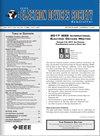Electrical and 850 nm Optical Characterization of Back-Gate Controlled 22 nm FDSOI PIN-Diodes Without Front-Gate
IF 2.4
3区 工程技术
Q3 ENGINEERING, ELECTRICAL & ELECTRONIC
引用次数: 0
Abstract
We present electrical and optical无前门的22nm后栅控制FDSOI pin -二极管的电学和850nm光学特性
我们给出了没有正门的反向控制SOI pin -二极管的电学和光学$(\lambda =\rm {850~nm })$测量结果,其固有Si膜厚度仅为${\sim }\rm 6nm $。这些超薄体pin -二极管是作为探索性器件,在商用的完全耗尽绝缘体上硅(FDSOI)技术中制造的,不需要额外的工艺步骤。我们发现静电后门调谐显著影响电学特性和光响应性$({{R_{\mathrm { o}}}{}})$。这导致了一种新的方法来提取最优后门偏差${R_{\mathrm { o}}}{}$从电测量。在二极管上0V偏置和最佳反向偏置下测得的最大带宽${R_{\mathrm { o}}}{}$等于$62{\mu }$ A /W, -3dB带宽为5.9GHz, -6dB带宽为15GHz。这些pin -二极管有可能为新的(太赫兹)电路、传感器、新型/互补过程控制监测结构和光学应用开辟道路。它们还支持混合(散装)和SOI设备之间的交互,这是FDSOI技术的独特功能。
本文章由计算机程序翻译,如有差异,请以英文原文为准。
求助全文
约1分钟内获得全文
求助全文
来源期刊

IEEE Journal of the Electron Devices Society
Biochemistry, Genetics and Molecular Biology-Biotechnology
CiteScore
5.20
自引率
4.30%
发文量
124
审稿时长
9 weeks
期刊介绍:
The IEEE Journal of the Electron Devices Society (J-EDS) is an open-access, fully electronic scientific journal publishing papers ranging from fundamental to applied research that are scientifically rigorous and relevant to electron devices. The J-EDS publishes original and significant contributions relating to the theory, modelling, design, performance, and reliability of electron and ion integrated circuit devices and interconnects, involving insulators, metals, organic materials, micro-plasmas, semiconductors, quantum-effect structures, vacuum devices, and emerging materials with applications in bioelectronics, biomedical electronics, computation, communications, displays, microelectromechanics, imaging, micro-actuators, nanodevices, optoelectronics, photovoltaics, power IC''s, and micro-sensors. Tutorial and review papers on these subjects are, also, published. And, occasionally special issues with a collection of papers on particular areas in more depth and breadth are, also, published. J-EDS publishes all papers that are judged to be technically valid and original.
 求助内容:
求助内容: 应助结果提醒方式:
应助结果提醒方式:


